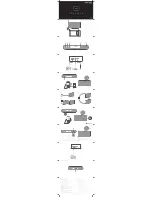
49
Using loudspeaker cables
The way cables are deployed and handled
can also exert a powerful influence on the
sound of the system. There are a number
of basic rules which should be considered
in this respect:
1. Best possible quality can only be
achieved when the cables to the right
and left speakers are of equal length.
2. Speaker cables should not be kinked
or squashed. If the cable has to cross
a doorway we recommend using a
cable duct; don’t just jam the cable in
the door!
3. Rolling up overlength cables is not
recommended. It is better to lay out
excessive
cable
length
in
a
meandering to-and-fro pattern. Co-
axial cable is of quite different
construction, and because of this it can
safely be coiled without any adverse
effect on sound quality.
4. As a general rule speaker cables
should not be deployed in the vicinity
of LF cables (inter-connects), as this
could result in cross-talk problems.
Take particular care in this respect with
any phono (vinyl disc player) cables,
as they are especially sensitive.
If you intend to bi-wire your speakers, note
that the same cable should be used for all
the frequency ranges.
The cables in the
range are very
highly specified, and are suitable for the
entire frequency range.
If you are a listener who prefers a light,
fast, and very precise sound with a dry
bass, we recommend the use of
Speaker
Koax
cable.
If you prefer a slightly softer balance with
less presence and a warm bass, we
recommend
Speaker Six
cable.
Caution:
Loudspeaker cables can carry very high
voltages and currents. For this reason it is
essential to ensure that no short-circuits
are present, and that the cable insulation
is not damaged. Never place an item of
furniture on the speaker cable. When
connecting cables to the speakers and
amplifier the first step must always be to
switch off the equipment.








































